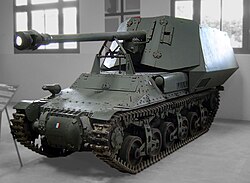| Lorraine 37L | |
|---|---|
 Marder I tank destroyer using a Lorraine 37L as chassis. The Lorraine 37L is clearly visible on the lower half of the vehicle below its gun-holding superstructure as the vehicle chassis | |
| Type | Tracked carrier |
| Place of origin | France |
| Service history | |
| Used by | France, Nazi Germany, Syria |
| Wars | World War II |
| Production history | |
| Designer | Lorraine |
| Designed | 1936 |
| Manufacturer | Lorraine, Fouga |
| Produced | January 1939 - November 1942 |
| No. built | ~480 by June 1940; ~630 in total |
| Specifications | |
| Mass | 6.05 metric tonnes loaded |
| Length | 4.20 m (13 ft 9 in) |
| Width | 1.57 m (5 ft 2 in) |
| Height | 1.29 m (4 ft 3 in) |
| Crew | two |
| Engine | Delahaye type 135 6-cylinder inline 70 hp |
| Payload capacity | 810 kg + 690 kg |
| Suspension | leaf spring |
| Ground clearance | 30 cm (12 in) |
| Fuel capacity | 114 litres |
Operational range | 137 km (85 mi) |
| Maximum speed | 35 km/h (22 mph) |
The Lorraine 37L or Tracteur de ravitaillement pour chars 1937 L, ("tank supply tractor 1937 L") is a light tracked armoured vehicle developed by the Lorraine company during the interwar period or interbellum, before the Second World War, to an April 1936 French Army requirement for a fully armoured munition and fuel supply carrier to be used by tank units for front line resupply. A prototype was built in 1937 and production started in 1939. In this period, two armoured personnel carriers and a tank destroyer project were also based on its chassis. Mainly equipping the larger mechanised units of the French Infantry arm, the type was extensively employed during the Battle of France in 1940. After the defeat of France, clandestine manufacture was continued in Vichy France, culminating in a small AFV production after the liberation and bringing the total production to about 630 in 1945. Germany used captured vehicles in their original role of carrier and later, finding the suspension system to be particularly reliable, rebuilt many into tank destroyers (Panzerjaeger) of the Marder I type or into self-propelled artillery.